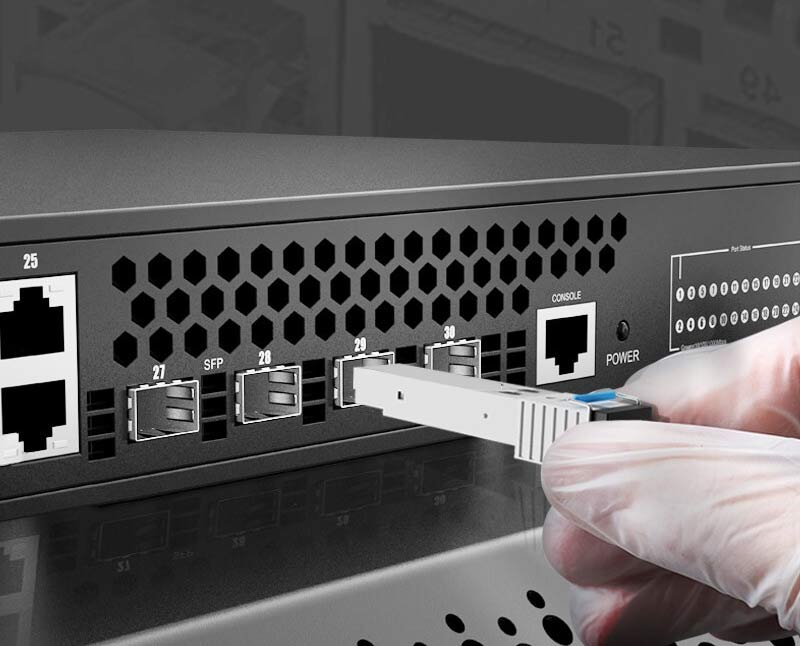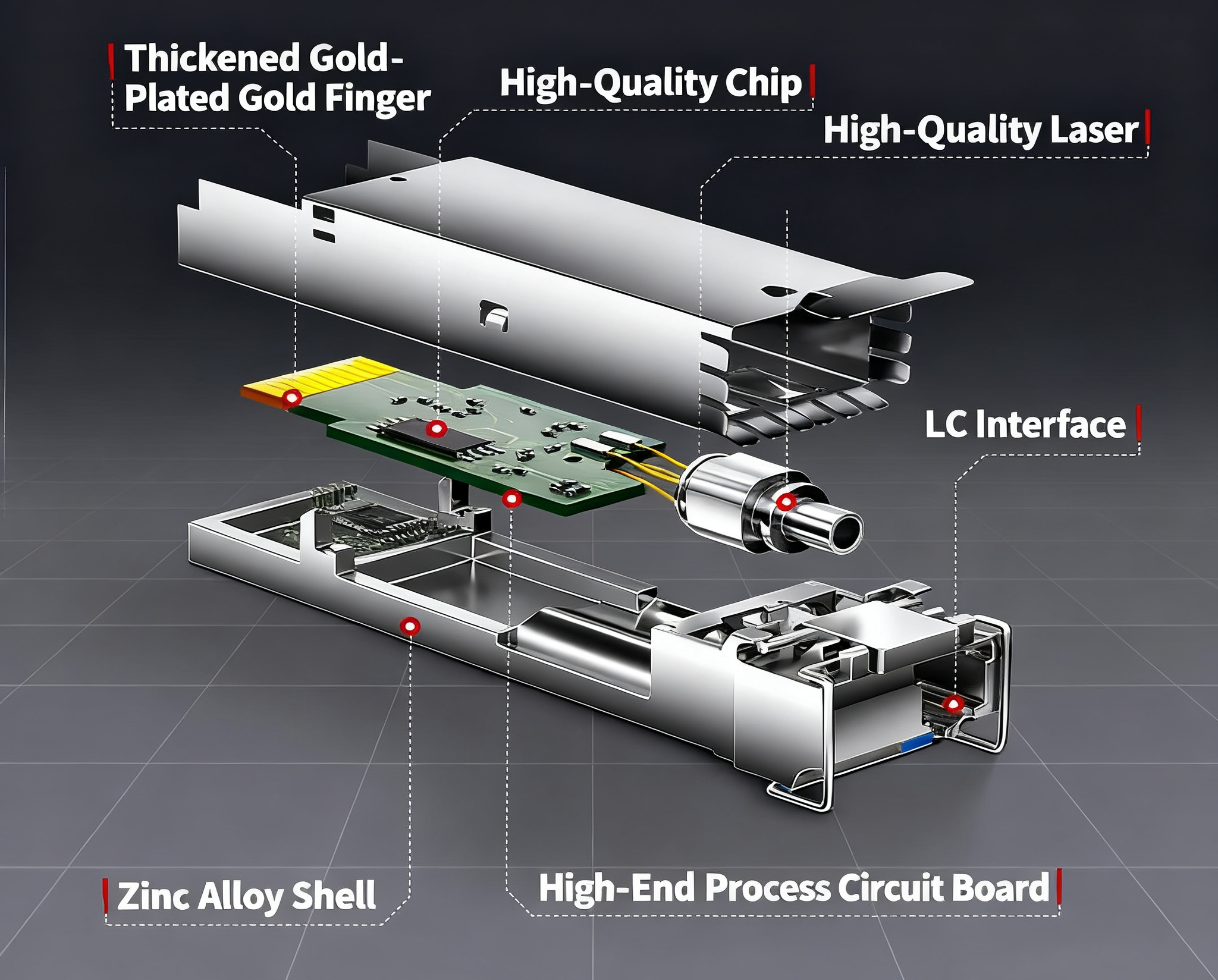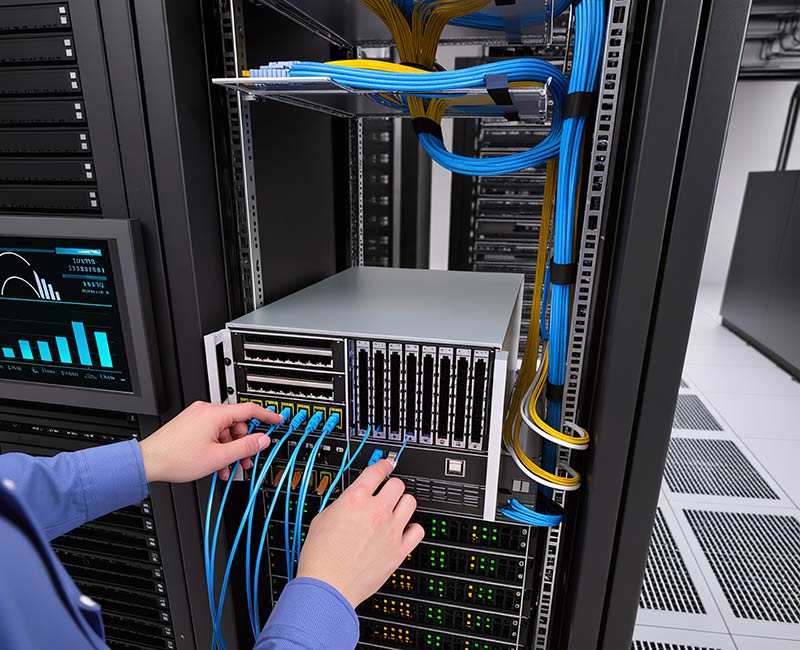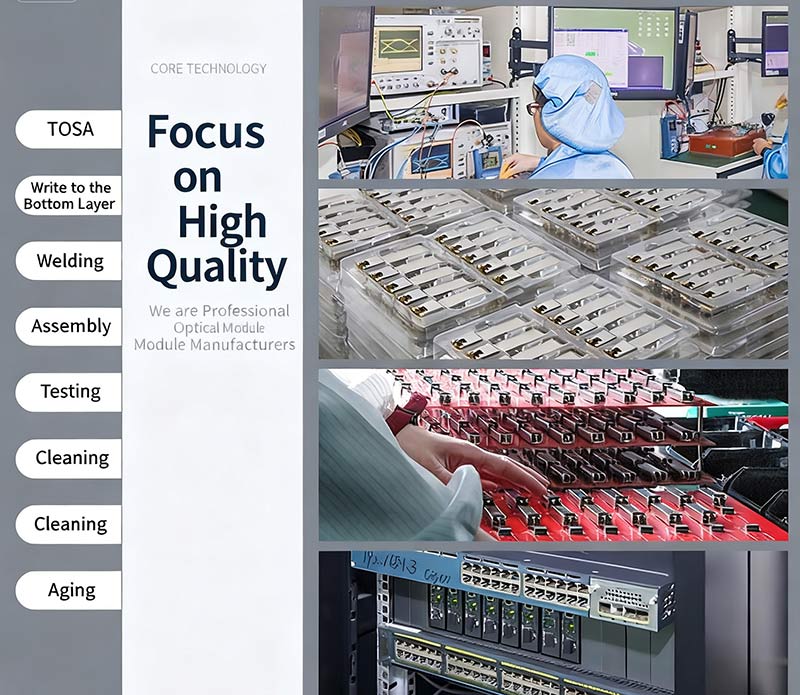How to Plan and Execute a 25G SFP Module Upgrade in Enterprise Networks

Many enterprise networks are under tremendous pressure to keep up with the acceleration of cloud services, AI-based applications, and big data workloads. These demands create congestion that can disrupt critical business processes and compel organizations to slow or even halt growth. One of the most efficient ways to move beyond these congestion points is by incrementally upgrading to 25G SFP modules, which provide an effective balance of better performance, cost efficiency, and scalability that can adapt to growth with any enterprise network designed to evolve.
In this guide, we will explain the technology behind 25G SFP and how it improves the enterprise environment. We will also define a strategy to deploy and maintain the new infrastructure, providing IT stakeholders and network engineers with actionable knowledge to evolve and enhance their networks and prepare their enterprises for the challenges of growing data demand.
What Are the Four Core Pain Points Driving Enterprises Beyond 10G Networks?
Enterprise networks today are experiencing explosive bandwidth growth, driven by increasing virtualization, hybrid cloud adoption, and data-intensive big data analytics. Virtual machines, containers, and cloud services are multiplying data flows, pushing the current infrastructure to its limits. Simultaneously, hybrid cloud environments are challenging enterprises to seamlessly move data and workloads between their on-premise resources and the cloud, increasing complexity and load on the enterprise network.
The 10G network bottleneck is quickly becoming a critical limitation. Under heavier traffic conditions, latency increases drastically, congestion in the data center slows down mission-critical applications, and it is these delays that will begin a cascading effect of slower processing of transactions, worse consumer satisfaction, and lower company operational efficiency.
In addition, the reality could be a performance bottleneck that robs an enterprise of innovative technology. Without 10G speed upgrades, businesses will find it increasingly challenging to reliably deploy AI workloads, real-time analytics, or edge computing, limiting their iteration and response to market changes.
Ultimately, once you understand the inefficiencies associated with current enterprise network speeds, you can begin to understand the importance of evolution beyond 10G networks. Solving data center congestion and overcoming current bandwidth issues will ultimately improve your operations and move you towards a future-proof enterprise infrastructure capable of supporting business demands and changes.

How Does SFP28 Technology Unlock 2.5x Performance Gains Over 10G for Enterprises?
SFP28 technology is changing enterprise networks by enabling speeds of 25G while still being backward compatible with the existing infrastructure. There are improvements at the physical layer, including improved signal modulation and improved electrical interface standards, allowing 25 gigabits per second to be handled on a single lane. Compared to the 10G SFP+ modules, this is a 2.5x increase in bandwidth without any changes to the existing cabling infrastructure.
Switch architectures that are designed for enterprise use and consideration of SFP28 increase port density without an increase in power consumption. Effective thermal management design reduces the heat produced and designs out common space and energy constraints that result in reduced rack space in the data center, ultimately increasing the number of switches that are more power-efficient while lowering operational costs.
In the real world, side-by-side comparisons of 25G SFP28 transceivers lead to lower latency and improved throughput when under heavy workloads when compared to the 10G modules. This results in operational efficiencies with “mission-critical applications” with better response times using less energy, employing additional strategies to create an easier path for network agility when it comes to deliverables. Lastly, when using the SFP28 technology, enterprise customers are future-proofing their networks by permitting scalable enterprise-grade networks while keeping up with the higher demand of data and improving overall efficiencies and dependability.
Why Is 25G Essential for Accelerating Enterprise Digital Transformation and New Infrastructure Initiatives?
Businesses that are expanding edge computing, private clouds, and AI-driven workloads demand networks that will keep up with the growing speed of their edge computing workloads. The 25G SFP module is the solution that will fill that gap by providing a fast, scalable connection that will support the three strategic priorities noted within this document. It is a matter of getting your workloads processing close to the data source to reduce delay and enhance the responsiveness of your applications.
For new infrastructure builds and projects, 25G enables future-proofing networks so that we do not have to constantly rebuild our infrastructure over the next 5-10 years to support the rapid growth of network traffic. There is capacity with 25G that allows infrastructures to grow with new business models, market demands, and regulations that are commonplace in corporate America. With the sheer volume of traffic entering and exiting systems, it supports a gradual evolution of their infrastructure and systems as newly identified and prioritized needs arise.
Use cases like real-time analytics, increased workloads from IoT devices, and hybrid cloud integration exemplify the reliability and scale of adoption of 25G services to be leveraged by businesses. The adoption of 25G will prepare enterprises to confidently leverage new applications and technology, ensuring their competitive agility remains intact via built-in high-speed connections focused on enterprise digital transformation and productivity along their newly adopted infrastructure.

What Are the Five Critical Steps to Planning a Successful 25G SFP Network Upgrade?
To upgrade to 25G SFP modules requires careful planning to satisfy enterprise-grade criteria. It all begins with an assessment of existing network requirements and infrastructure capabilities. Understanding current bottlenecks helps develop a focused upgrade strategy.
The next step is to validate that the new 25G modules are compatible with the legacy infrastructure so that costly integration problems do not occur. Cost efficiency, by methodically weighing the investment in new hardware against all the long-term gains, such as lower latency and reduced energy consumption, should be the next consideration.
Next, upgrades should be executed with minimal downtime to maintain business continuity. Lastly, upgrades should facilitate scaling the network as the organization’s future requirements may be arriving sooner than anyone is anticipating. These scaling strategies account for a seamless growth trajectory of the network.
By aligning every preceding step with enterprise IT policies and goals related to the reduction of disruption, companies will ease into the upgrade process. Once a company has completed the five steps contained herein, it is equipped to upgrade with confidence, enabling the enterprise to fully realize the many benefits of 25G, without resistance from daily operations or impact on budgets.
How to Ensure Smooth Compatibility Between 25G SFP Modules and Existing SFP28 Switches in Complex Enterprise Environments?
Ensuring compatibility between 25G SFP modules and SFP28 switches introduces some unique challenges for enterprise networks—especially where there are multiple vendors involved—due to firmware versions and hardware revisions across switches. All of these variables can lead to unexpected compatibility issues resulting in link failures, degraded performance, or network outages affecting business-critical services.
Enterprises must have robust pre-deployment validation methods. Vendor interoperability matrices are a powerful method to ensure compatibility for 25G SFP modules and SFP28 switches. These matrices create a compatibility map of tested modules and switches. In-house testing is also a valuable testing method as it puts conditions in the real network environment, which identifies hidden risks. Stress testing, specifically looking for high traffic and extended uptime issues, will identify potential failure points before the modules are deployed in the enterprise environment and allow for mitigation methods to be established.
Common problems with compatibility include mismatched transceiver parameters, firmware issues related to incompatibilities between different vendors, and thermal issues caused by the 25G SFP modules that are not designed to handle thermal loads of SFP28 switches.
Best practices for implementation to mitigate problems include ensuring that firmware is updated, using vendor-certified modules for the SFP28 switch being installed, and working with vendors if any issues arise with potential compatibility or performance issues. Pre-deployment testing can help minimize risk and offer some peace of mind when the 25G SFP module is deployed amongst a complex enterprise infrastructure. The more that the unique compatibility issues can be mastered, the more the potential for costly outages is reduced, and reliable performance of the network can be guaranteed.

How to Balance Cost and Return in 25G SFP Deployments Tailored for Enterprise ROI?
When implementing 25G SFP modules into the enterprise network, it’s essential to manage costs for maximum return. The total cost of ownership (TCO) is comprised of the hardware cost, any downtime from installation, ongoing maintenance, power requirements, and cooling costs. All of these factors ultimately come together to provide a total cost of ownership, which is the financial impact of your upgrade to the network.
Besides the costs that can easily be quantified, enterprises must think through the intangible ROI topics. Improved network agility will allow the business to react faster to changes in the market. When the network has lower latency, it will increase the speed and efficiency of business-critical applications, and therefore better operational efficiency. Furthermore, future scalability built into the 25G SFP will help protect your current investments against data growth occurring much faster than anticipated.
Collaboration over budgeting that allows for CFOs and IT to have effective dialogue helps make smarter financial decisions. Linking the technical benefits to the enterprise’s business strategy will ultimately help justify any expenditure incurred from implementing new networking technology. An overall understanding of the tangible and intangible factors will help enterprises ensure that the investment into 25G SFP deployments makes sense, fits long-term value, and accounts for the costs of SFP28 deployment. Finally, the enterprise upgrade will ultimately bring positive outcomes that meet measurable results, while meeting the enterprise’s broader goals.
How One Enterprise Realized a Successful 25G Upgrade and Measured Tangible Business Impacts
A prominent financial institution was experiencing increasing network congestion that impacted transaction latency and the ability to analyze real-time data for competitive analysis. It was clear that a legacy 10G network architecture was not supporting peak workloads at the time without highly impactful latency and reduced throughput.
The upgrade would occur in phases, and the first phase was to conduct compatibility testing between 25G SFP optical transceivers and their existing SFP28 switches. Adequate prep work was done to understand the deployment plan, which also prioritized disruption to service as the busiest data center segments were selected over any other option. Once the upgrades were completed, metrics were reviewed, and the organization saw a 2.5x increase in throughput and a latency drop of over 40%, dramatically improving application performance.
This 25G SFP case study is about more than just technical improvements; it was also in perfect alignment with the organization’s digital strategy and commitment to speed and agility. The fast upgrade to 25G SFP helped the organization support improved processing of Big Data within a digital environment and supported building a more resilient foundation for AI exploits. Companies looking at 25G-related upgrades will also find important lessons from the case study about large performance gains, which should also be viewed in the context of organization-wide digital transformation.
What Are Best Practices for Selecting 25G SFP28 Modules Based on Real-World Enterprise Data?
When searching for the correct 25G SFP28 transceiver, the right balance between performance and practical efficiency is necessary. Real-world enterprise utilities show that the power draw of each manufacturer varies by an order of magnitude from one to the next, directly impacting energy budgets and cooling. Modules with lower thermal profiles may reduce vendor cooling requirements in higher density switch footprint environments—protecting the lifespan of hardware.
Error rates are the most critical quality metric; error counts are inversely related to retransmission and network reliability, and comprehensive evaluations must include side-by-side SFP28 comparison testing based on interoperability and transceivers across switch vendors. Multi-vendor compatibility facilitates deployment flexibility and reduces the drawbacks from vendor lock-in considerations.
Scalability is also an important consideration; choosing a module that promotes future infrastructure planning embedded in the module now can pay off years from now when retrofits or replacements are required when moving to higher speeds. Criteria based on empirical performance serve to improve enterprise confidence in their transceiver choice-based network resilience, growth potential, and costs.

How to Monitor and Maintain 25G SFP Modules to Ensure Long-Term Stability in Enterprise Networks?
To avoid an interruption in your operations, enterprise networks need a carefully designed process for monitoring 25G SFP modules to identify potential faults before they cause issues. Real-time monitoring and management of SFP modules provide immediate visibility into operating status and can identify system issues like signal degradation, excessive temperature, or internal power loss. The information obtained from real-time monitoring and management allows IT teams to take timely action to avoid costs associated with downtime.
Proper maintenance is also a key component in maintaining the health of hardware and components. For example, keeping the firmware updated, making sure the optical interface surfaces are clean, and implementing preventative inspections and testing can all help lower the error rate and extend the life of the module. In areas of heavier enterprise traffic, monitoring and maintenance allow organizations to ensure throughput and performance remain reliable and stable.
Multiple management approaches can allow for 25G SFP28 module management and monitoring to help identify potential faults and aid in general maintenance to enhance the performance and lifespan of the components. These approaches together allow for maintaining reliable and consistent network performance during peak workloads. Having the ability to manage your monitoring strategies allows organizations to maintain 25G networks over time, supporting mission-critical applications without disruption to operational performance.
How Will 25G SFP Modules Evolve and Propel Enterprise Networks Toward 100G and Beyond?
The foundation for increasing speeds forward to 100G and beyond is built on the 25G SFP modules. Emerging chipsets and integrated optics are improving data transmission cost-per-bit by reducing latency and power consumption, while allowing for greater throughput. These enhancements create modular upgrade paths to accommodate the changing requirements of the network.
Network topologies are evolving toward a model of increased flexibility, with software-defined enterprise networks enabling enterprises to dynamically adjust bandwidth capacities. The transition to 25G SFP technology with future-proofing capabilities will allow seamless transitions to 100G upgrade paths to avoid disruption and protect initial investments.
Enterprises looking for scalable solutions now position themselves to address evolving data challenges with less disruptive infrastructure renovation, even as 25G option prices come down. This crystal ball approach will allow agencies to more easily establish a balance between immediate needs and longer-term agility, creating a persistent competitive advantage.
Conclusion
The 25G SFP modules tackle vital enterprise bottlenecks such as increased bandwidth, latency, and scalability. Their deployment allows enterprises to embrace new workloads and serves as a foundation for certain aspects of digital transformation. When IT leaders acknowledge some of the benefits of 25G SFP modules, they can begin to future-proof their infrastructure.
Embedding 25G in your network and comprehensively planning the deployment will maximize the benefits. The transition should prioritize compatibility, cost, and maintenance considerations. By moving forward as expediently as possible, enterprises can remain competitive and agile in an ever-changing data landscape and ensure their network is not a detriment to business development.
